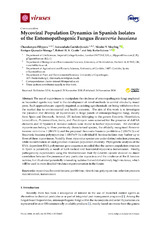Mycoviral Population Dynamics in Spanish Isolates of the Entomopathogenic Fungus Beauveria bassiana
Autor
Filippou, Charalampos
Garrido-Jurado, Inmaculada
Meyling, Nicolai V.
Quesada-Moraga, Enrique
Coutts, Robert H.A.
Kotta-Loizou, Ioly
Editor
MDPIFecha
2018Materia
MycovirusBeauveria bassiana
Partitivirus
Victorivirus
Polymycovirus
Selection pressure
METS:
Mostrar el registro METSPREMIS:
Mostrar el registro PREMISMetadatos
Mostrar el registro completo del ítemResumen
The use of mycoviruses to manipulate the virulence of entomopathogenic fungi employed
as biocontrol agents may lead to the development of novel methods to control attacks by insect
pests. Such approaches are urgently required, as existing agrochemicals are being withdrawn from
the market due to environmental and health concerns. The aim of this work is to investigate
the presence and diversity of mycoviruses in large panels of entomopathogenic fungi, mostly
from Spain and Denmark. In total, 151 isolates belonging to the genera Beauveria, Metarhizium,
Lecanicillium, Purpureocillium, Isaria, and Paecilomyces were screened for the presence of dsRNA
elements and 12 Spanish B. bassiana isolates were found to harbor mycoviruses. All identified
mycoviruses belong to three previously characterised species, the officially recognised Beauveria
bassiana victorivirus 1 (BbVV-1) and the proposed Beauveria bassiana partitivirus 2 (BbPV-2) and
Beauveria bassiana polymycovirus 1 (BbPmV-1); individual B. bassiana isolates may harbor up to
three of these mycoviruses. Notably, these mycovirus species are under distinct selection pressures,
while recombination of viral genomes increases population diversity. Phylogenetic analysis of the
RNA-dependent RNA polymerase gene sequences revealed that the current population structure
in Spain is potentially a result of both vertical and horizontal mycovirus transmission. Finally,
pathogenicity experiments using the Mediterranean fruit fly Ceratitis capitata showed no direct
correlation between the presence of any particular mycovirus and the virulence of the B. bassiana
isolates, but illustrated potentially interesting isolates that exhibit relatively high virulence, which
will be used in more detailed virulence experimentation in the future

